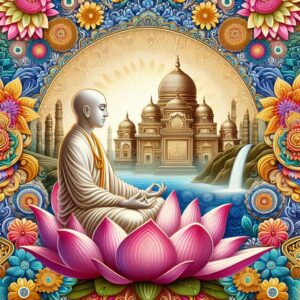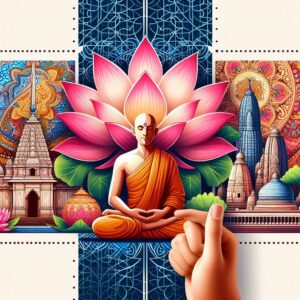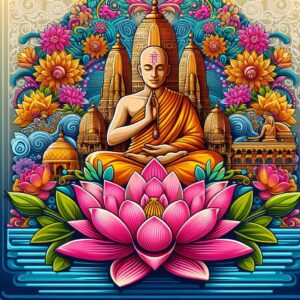The word Jain is derived from the word Jin which means conqueror, that is, one who has conquered his senses. The followers of Jin are called Jains.
The teachers of Jainism are also called Tirthankaras. Tirthankara means the maker of ghats. There are a total of 24 Tirthankaras in Jainism. The first Tirthankara of Jainism was Rishabhdev/Adinath/Kesariyanath. They died on Mount Kailash. 20 Tirthankaras of Jainism have died on Sammed Mountain in Jharkhand. Anishtanemi died in Girnar, Vasupujya died in Chammapapuri (Bihar) and Mahavir Swami died in Pavapuri (UP). The 23rd Tirthankara of Jainism is Parshvanath who started the Nirgranth community. Parshvanath had introduced 4 Vrats – Satya, Ahimsa, Asteya (not stealing), and Aparigraha (not accumulating wealth). Mahavir Swami included only celibacy.

Mahavir Swami
Mahavir Swami was born in 599 BC in a place called Kundagram in Vaishali. His father’s name was Siddhartha he was the head of the Jnatrika clan of Kundagram. His mother’s name was Trishala/Videhadatta/Priyakarini and she was the sister of Chetak, the chief of the Licchavi tribe.
The name of Mahavir Khami’s elder brother was Nandivardhan. Mahavir Swami’s sister’s name was Sudarshana. Mahavir Swami was married to Yashoda/Yashodhara. Mahavir Swami’s daughter’s name was Priyadarshana/Anuja who was married to Sudarshana’s son Jamali. Jamali was the first disciple of Mahavir Swami. Mahavir Swami’s initial name was Vartaman
At the age of 30, after obtaining permission from his elder brother Nandi Vardhan, Mahavir Swami renounced worldly things. He spent the first 6 years in Nalanda doing tapasya with the Acharya of his sect, Makkhaliput Goshal. At the age of 42, Mahavir Swami got enlightenment on the banks of the river Ujjuwalia or Rijupalika. After this, he was called Arhat (worthy), Kaivalin (person with full knowledge), Jitendra (conqueror of senses) and Mahavir.
The description of the rigorous penance of Mahavir Swami is found in the texts named Kalpasutra and Acharangasutra.
Chandana, daughter of Dadhivahan, the ruler of Champa (Bihar) district, was the first disciple of Mahavir Swami. Mahavir Swami died in 527 BC in the palace of Hastipal, the ruler of Malla Republic in Pavapuri. In Buddhism, Mahavir Swami is called Nigathnathput.
Mahavira Swami had established Jain Sangha during his lifetime. Jain Sangha was called Gana and its head was called Ganadhar. Mahavira Swami had appointed 11 Ganadhars during his lifetime. The first Jain Sangha was established in Pawa (UP). Indrabhooti was the first Ganadhar. During the time of Mahavira Swami, only a Ganadhar named Sudharman was alive. After the death of Sudharman, Jambuswami led the Jain Sangha for 44 years but the history of Jainism is not known for the next 150 years.
Mention of Jainism is found in the Mauryan period when the Jain Sangh in Magadha was led by Sambhuti Vijay and Bhadrabahu. Magadha was facing a famine of 12 years, and the Mauryan ruler Chandragupta Maurya adopted Jainism. He went to Shravanabelagola (Karnataka) along with Bhadrabahu. After the death of Sambhuti Vijay, the Jain Sangh in Magadha was led by Sthulabhadra. He allowed his followers to wear clothes due to the famine. The followers of Bhadrabahu were called Digambaras, and the followers of Sthulabhadra were called Swetambars.

Education and Philosophy
Jainism believes that the world is full of sorrow and the cause of sorrow is greed. Due to greed, our karmas flow towards the soul, which is called asrava. After this, the karmas get attached to the soul, which is called bondage.
By observing the Triratnas, the flow of karmas stops which is called Samvara. By constantly observing the Triratnas, these karmas start getting destroyed which is called Nirjara (freedom from suffering). When the karmas are destroyed then the person attains Kevala, i.e. complete knowledge.
Triratna of Jainism
1. Right View
It has 8 parts
- Amudh Drishti: Following the teachings of Mahavir Swami
- Vatsalya: having affection towards Jain monks
- Prabhavana: serving religion with body, mind, and money
- Upaguhana: never criticize religion
- Statuskaran: if one or another person has deviated from religion, then bringing him back to the same state
- Nirvichikitsaka: serving sick/sick Jain monks.
- Do not doubt the devotion of Jain monks
- Unshakchit: to remain steadfast in religion.
2. Proper Knowledge
It has two parts –
- Direct knowledge: It includes practical and spiritual knowledge. Practical knowledge is based on Mati (Busti) and Shruti (Gunna). Spiritual knowledge – It has three parts – Avadhi – Knowing the presence of an object at a particular place. Manaparyaya – Knowing what is in the mind of another person.
Kevalya: Complete knowledge - Indirect knowledge: based on inference
3. Proper Character
It has five parts-
- Truth
- Nonviolence
- Uncultured
- Aparigraha
- Celibacy
If a householder worships these five circles then it is called Anuvrat and if a Jain monk worships it then it is called Mahavrata.

Visits
The philosophy of Jainism is called Anekantavada / Syadvada / Saptabhangi Siddhanta. In Jainism, it is believed that there are many things in the world and those things have many qualities. At first sight, we cannot tell about all the qualities of that thing. Incomplete knowledge about things is called Naya. Complete knowledge about an object can be told in 7 ways. In Jainism, it is explained with the example of a half-baked person and an elephant.
Jain associations
1. First Jain Council
- Time – 300 B.C.
- President – Sthulabhadra
- Location – Pataliputra
- Mahavira’s original teachings were compiled in 14 Pubbas (Purvas) and written in 12 parts. The Digambara community does not accept the 18th part as knowledge is only Samrtivijaya and does not believe in the 12th part or Sthulmad.
2. Second Jain Sangit
- Time – 512-13 A.D.
- Location – Vallabhi
- President – Devardhi Shramashram
- Patron – Shramana Sen, Ruler of Maitraka Dynasty
- The entire Jain literature was written in the Pali language in Agam.
Difference Btw Svetamber & Digambars
| Svetambara | Digambaras |
| 1. Their method of sadhana is simple. 2. Giving up one’s life while remaining hungry and thirsty is called Santhāra. 3. At the end of his literature, the characters seem to be 4. The 19th Tirthankar Mallinath is considered a woman | 1. Their method of sadhana is extremely difficult. 2. Giving up one’s life by remaining hungry and thirsty is called Sanlekhana. 3. Puranas are placed at the end of the literature. 4. The 19th Tirthankar Mallinath is considered a man. |